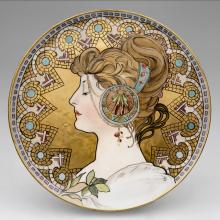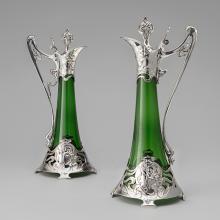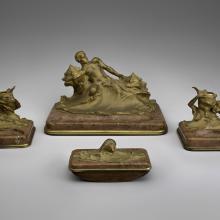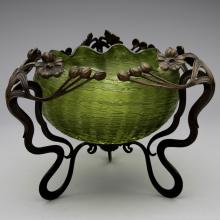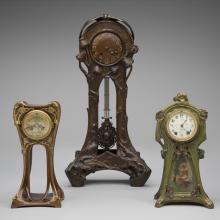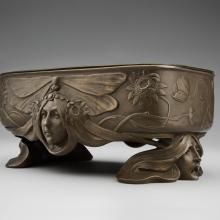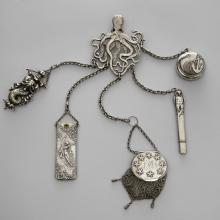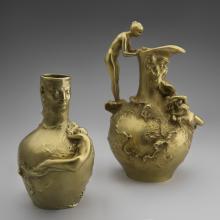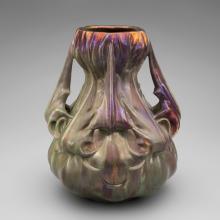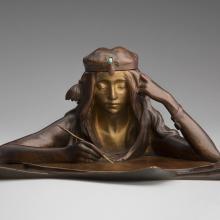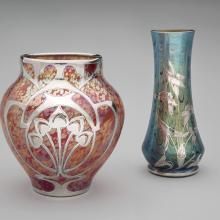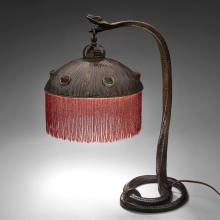International Terminal












La Plume plaque 1899
Alphonse Mucha (1860–1939)
Jean Pouyat Factory
Limoges, France
porcelain
From the Collection of David and Julie Vezmar
L2015.2504.002
Art Nouveau graphic artists used the feminine form as a focal point, perhaps none more so than Alphonse Mucha (1860–1939). His artwork represents the culmination of Art Nouveau graphic arts. Born in Moravia, in what is now the Czech Republic, Mucha first worked as a stage painter and attended the Académie Julian in Paris before he became a renowned graphic artist and designer. In 1894, Mucha was commissioned to design a poster for Gismonda, a play that starred the famous French actress Sarah Bernhardt. The poster made Mucha an instant success. His design for the La Plume plaque demonstrates the artist’s trademark style—it portrays a pensive female face framed by thick, wavy hair, against an intricately patterned background.
Pair of decanters c. 1910
WMF
Germany
glass, silver plate
The Antique Traders, San Francisco
Courtesy of Alan Schneider
L2015.2502.016.01-.02
The malleability and brilliance of silver lent itself to the style of Art Nouveau. Württembergische Metallwarenfabrik of Germany, commonly referred to as WMF, was a major producer of silver-plated items in the Art Nouveau style, known as Jugendstil in Germany. Famous for its patented process of electroplating flatware, WMF released a catalog devoted to the new style in 1906 entitled, “Art Nouveau Domestic Metalwork.” The firm employed over six thousand workers in Austrian, German, and Polish factories. These silver-and-green glass decanters are excellent examples of WMF’s prized work.
Desk set c. 1900
Hans Müller (1873–1937)
Austria
gilt bronze, marble
Courtesy of Chuck Morgenstern, Woodchuck Antiques, San Francisco
L2015.2501.004.01-.04
The desk set shown here is unusually rare; instead of portraying a woman, this bronze and marble inkwell depicts a sinuous Poseidon emerging from waves and a male and female pair of candlesticks. Art Nouveau manufacturers offered a variety of metalwork desk items, particularly inkwells cast in bronze. Though produced in fairly large numbers, desk items were fabricated with great care. Many of these pieces were produced in gilded bronze. Gilding entails applying fine gold leaf or powder to bronze, which leaves the surface with a thin coating of gold.
Centerpiece 1900
Loetz
Austria
glass, bronze
Courtesy of Age of Elegance, Mill Valley, California
L2015.2504.001
The Art Nouveau movement encouraged artists, architects, and designers to create modern, innovative designs. The advent of the style can be traced to several influences: the first was the introduction of the Arts and Crafts Movement in the 1880s, led by the English designer William Morris (1834–96). In response to the Industrial Revolution, the movement emphasized a return to hand craftsmanship. Both Arts and Crafts and Art Nouveau artists rejected revivalist styles and sought to move away from the cluttered designs and compositions of Victorian-era decorative arts. Around the same time, the Aesthetic movement promoted the doctrine, “art for art’s sake,” or the celebration of art simply for the pleasure drawn from its beauty. Also of critical importance, Symbolist artists were exploring the inner world of the psyche and spirit, making myths, dreams, and religion their subject matter. Meanwhile, the vogue for Japanese art, offered an alternative to established European styles. Japanese woodblock prints contained stylized organic forms and dynamic, curvilinear lines, which would become hallmarks of the Art Nouveau style.
Clock 1900 | Clock c. 1900–10 | Clock c. 1900–10 |
When Art Nouveau infiltrated western design at the close of the nineteenth century, clocks exhibited the style’s prevalent motifs. The female form, the natural world of plants, flowers, insects, and even bats, along with and Japanese-inspired imagery, such as spider webs were applied to clocks.
The Art Nouveau movement advocated that artists and designers should embrace all areas of decorative arts rather than confine their talents to one specific field. Talented designers of various expertise and backgrounds produced a variety of decorative objects for the home. In France, leading designers such as Louis Majorelle (1859–1926) and Emile Gallé (1868–1943) produced some of the most notable designs.
Jardinière 1903
Austria
bronze
Courtesy of Chuck Morgenstern,
Woodchuck Antiques, San Francisco
L2015.2501.001
Nature served as a driving force of the Art Nouveau movement, inspiring designers throughout Europe and North America. While many Art Nouveau artists took a realistic approach in their interpretations of nature, others created more fanciful designs, with natural imagery appearing in a mysterious, serpentine, dream-like state. Designers often explored metamorphic themes, melding a variety of human, animal, and plant forms together—combining insects, females, and flowers.
Alongside nature, no other subject matter was depicted so extensively as the female form. Artists portrayed women as enchanting, otherworldly maidens. The jardinière on display evokes this theme with a dragonfly that seems to meld with the woman’s head, while sunflowers and poppies appear to be growing from her hair. Art Nouveau artists’ elaborate portrayal of female tresses helped distinguish the design style. From decorative arts to paintings and illustrations, women’s hair serves as a focal point and takes on a life of its own. Locks flow, curve, and meander, often filling the entire canvas.
Octopus chatelaine c. 1900
William B. Kerr & Co.
Newark, New Jersey
800 silver, sterling silver
From the Collection of Mary Nunn
L2015.2510.001
At the turn of the twentieth century, North American designers looked to Europe for the latest fashion trends. Returning from various international exhibitions, they were quick to adopt the new, organic style. Jewelry by René Lalique (1860–1945) at the 1900 Paris Exposition Universelle—most importantly, his famous dragonfly-woman brooch—inspired many designers to draw upon the theme of metamorphosis. American makers also studied contemporary European art and design magazines as a source for Art Nouveau motifs and themes. Manufacturers offered a variety of items such as brooches, belt buckles, chatelaines—a fashionable female accessory made to hang from a woman’s waist belt—and purses with motifs often colored in enamel or stamped in low relief. These fashion accessories allowed the wearer or user of the items to demonstrate their taste and modernity.
Vase c. 1890s | Pitcher c. 1900 |
The proliferation of images of women, sometimes described as femme-fleurs, became a symbol of Art Nouveau, particularly in the medium of sculpture. The erotically charged nature of many of these works is one of the most prevalent features of the style. A new generation of sculptors, such as Auguste Ledru (1860–1902), abandoned historical subjects of the past. Instead, they explored new themes in both traditional formats and novel contexts including lamps, fruit dishes, and desk ornaments.
Auguste Ledru was born in Paris and studied sculpture at the École des Beaux-Arts. He executed numerous small sculptures based on sensual, unclothed nymphs in conjunction with natural forms, particularly shells and sea creatures.
Artichoke vase c. 1900–10
Ernest Bussière (1863–1913)
France
ceramic, glaze
Courtesy of John Melillo, Antiquarian Gallery
L2015.2505.009
Ceramic decoration, glazing, and firing techniques were pursued with a new passion by manufactories, local workshops, and individual artist-potters working in the Art Nouveau style. France took the lead in creating ceramics in the new style, but was joined in ensuing decades by other European makers as well as Louis Comfort Tiffany in the United States. The preference for porcelain, long considered Europe’s “white gold,” shifted during this period. Stoneware, viewed as a utilitarian form of ceramics, enjoyed newfound recognition at the close of the nineteenth century, particularly in France. The French art and design community embraced Japanese arts during this period. French potters were especially influenced by Japanese stoneware and glazes. They began crafting refined stoneware sculptures and vessels, which displayed a host of experimental glazes and organic forms that served as the focal point of the potter’s creativity.
Inkwell c. 1900–10
Gustav Gurschner (1873–1970)
Austria
bronze
Courtesy of John Melillo, Antiquarian Gallery
L2015.2505.015
Austrian-born Gustav Gurschner participated in the inaugural exposition of the Vienna Secessionists in 1898. Although he was influenced by the French interpretation of the Art Nouveau style after living in Paris for a large part of his career, Gurschner’s sculptures reflect his ties to the Viennese Secessionists. His metalwork, although often small in scale, displays exceptional refinement. Gurschner participated in various exhibitions in Paris, including La Société Nationale des Beaux-Arts in 1898 and the Paris Exposition Universelle in 1900.
Vases c. 1900
Loetz
Austria
glass, silver
The Antique Traders, San Francisco
Courtesy of Alan Schneider
L2015.2502.007, .010
Founded in 1840 in what is now the Czech Republic, Loetz became the premier Bohemian glass manufacturer by the 1890s, specializing in iridescent glass. Ancient Roman glass discoveries inspired late nineteenth-century glassmakers to produce lustrous glass. Tiffany in New York and Loetz in Austria perfected their techniques around the same time and were emulated by other manufacturers in the United States and Europe. Unlike French glass designers in Nancy, Loetz primarily avoided figural and literal interpretations of the natural world. Instead, the firm emphasized glass colors, textures, and patterns. A number of excellent works display an openwork overlay of electroplated silver. Many Loetz pieces were designed by some of the leading avant-garde artists of the day. Architect Josef Hoffmann (1870–1956) and designer Koloman Moser (1868–1918) collaborated with Loetz in the production of pieces for Viennese retailers. Painter Marie Kirschner (1852–1931) also created pieces for the firm from 1899 to 1914. Sculptor Gustav Gurschner (1873–1970) and architect Peter Behrens (1868–1940) produced a series of table lamps with iridescent shades and gilt metal or bronze bases for Loetz.
Snake lamp 1900
Vienna, Austria
bronze, glass
Courtesy of Age of Elegance, Mill Valley, California
L2015.2504.026
In Vienna, a collective of painters, decorators, sculptors, architects, and designers banded together to form the Viennese Secessionists (Sezessionstil) in 1897. The group sought to promote their work and organize exhibitions that resisted the conservatism that prevailed in many of Europe’s traditional art academies. Significant figures such as painter Gustav Klimt (1862–1918) and architect Otto Wagner (1841–1918) helped found the group. Their goal was to replace the popular historical styles with a modern style with equal importance assigned to form and function. In 1903, architect Josef Hoffmann (1870–1956) and designer Koloman Moser (1868–1918), both members of the Secessionist group, established the Wiener Werkstätte or Vienna Workshops, which emphasized the important role of craftsmanship and an integrated approach to the design of interiors. They intended to bring good design and craft into all areas of life within the fields of ceramics, metal, furniture, and graphic arts. Viennese designers took inspiration from the geometry of the Glasgow School of Art Nouveau artists and the simplicity of Japanese design.
